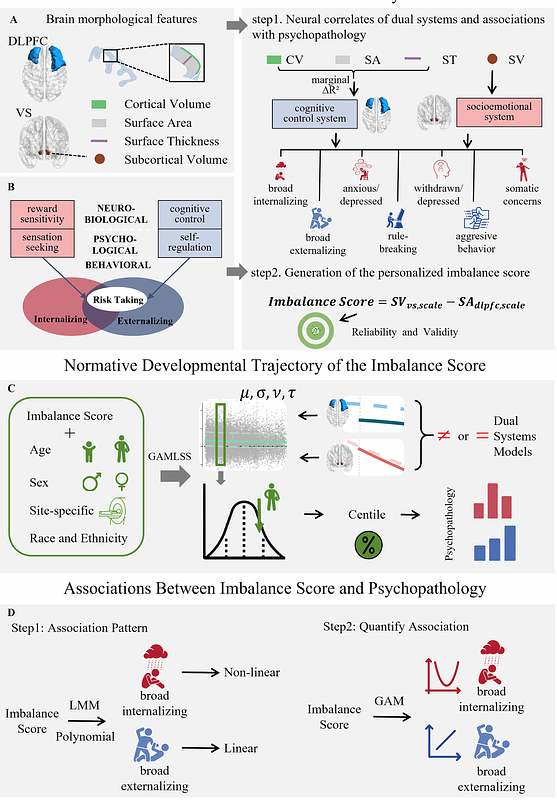Personalized Brain Morphometric Feature as a Transdiagnostic Predictor of Psychopathology: Insights from Dual Systems Models

Personalized Brain Morphometric Feature as a Transdiagnostic Predictor of Psychopathology: Insights from Dual Systems Models
Kang, M.; Song, K.-r.; Zhang, J.-l.; Xu, L.; Zhang, Y.; Zhao, Z.; Deng, H.; Fang, X.; Potenza, M. N.; Zhang, J.
AbstractBackground: Adolescents are particularly vulnerable to developing psychopathological symptoms, yet neurobiological markers that can identify these vulnerabilities in a personalized and interpretable manner remain limited. Dual Systems Models suggest that this vulnerability may result from asynchronous development of neural systems subserving cognitive-control and socioemotional functions. Given that rigorous empirical evidence is sparse, this study aimed to quantify developmental imbalances and evaluate their predictive value for psychopathology. Methods: Based on Dual Systems Models, the dorsolateral prefrontal cortex (DLPFC) and ventral striatum (VS) were selected as key regions for the two brain systems, respectively. Using longitudinal data from the Adolescent Brain Cognitive Development (ABCD) study [baseline: n=11,238, ages 9.92(0.625) years; 2-year follow-up: n=7,870, ages 12.2(0.652) years; 4-year follow-up: n=2972, ages 14.1(0.693) years], we derived a personalized imbalance score based on brain morphometric features, including surface area, thickness and gray-matter volume. Nested linear mixed models were employed to assess associations between the imbalance scores and psychopathology. Additionally, generalized additive models were used to capture developmental trajectories of the imbalance scores and explore potential non-linear associations with psychopathology. To examine reproducibility, data from the Lifespan Human Connectome Project in Development study (HCP-D, N=652, ages 8-21 years) were interrogated. Results: The imbalance score, quantified as the difference between VS volume and DLPFC surface area, exhibited strong reliability and validity. During adolescence, the score exhibited a declining trend, with decreasing growth rates and variability between individuals. The score was positively associated with externalizing symptoms and showed a U-shaped relationship with internalizing symptoms. These findings were replicated in the HCP-D sample. Conclusions: The novel neuroanatomical imbalance score empirically supports Dual Systems Models and may function as a transdiagnostic marker for internalizing and externalizing psychopathology. These findings enhance understanding of the neurodevelopmental mechanisms underlying adolescent psychopathology and offer potential implications for precision prevention and intervention strategies.